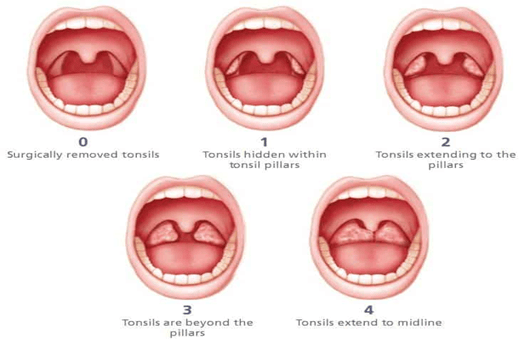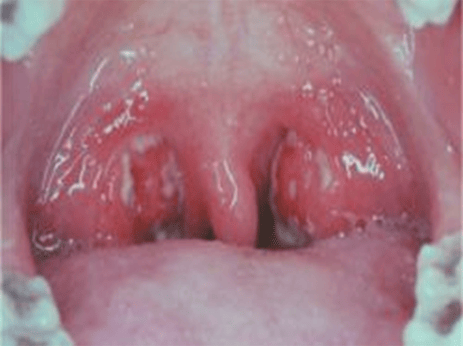Tonsils are part of the immune system and contain an abundance of white blood cells to combat germs from entering the body. They are part of mucous-associated lymphoid tissue (MALT).1 Tonsils are made with lymphocytes and cells that prevent and fight infections.1 The tonsils have antigen-presenting cells on their surface that communicate with the B and T cells as part of the immune system. The B cells produce antibodies IgA to provide immune protection on mucosal surfaces. The T cells directly kill the invaders by engulfing them or indirectly by stimulating other cells of the immune system.
Tonsils are covered with pink mucosa with crypts, which are small pits in each tonsil. Crypts embedded in them are normal anatomy. The average adult has 10 to 20 crypts. They are generally small and debris-free, although they may collect food, mucus, and debris. When this happens, it can lead to bad breath, a feeling of something stuck in the throat, a chronic sore throat, foul-smelling cheese-like clumps in the mouth, or tonsil stones.2
Waldeyer’s ring consists of four tonsils (see Figure 1). They form a ring around the opening of the throat, mouth, and nose. This positioning prevents germs, bacteria, and viruses from entering the body via mouth or nose. The four types of tonsils are adenoids, lingual, palatine, and tubal.3

Adenoids (pharyngeal tonsil of tonsillar pharyngealis) − The adenoids are found high in the throat behind the nose and can only be seen through rhinoscopy.4 They grow until the age of five and then begin to shrink at the age of seven, becoming very small in adulthood.5
Adenoids may become enlarged enough to completely block airflow through the nasal passages. With this blockage, mouth breathing will be more uncomfortable. Symptoms such as excessive mucus production may be a sign of adenoid infections.4,5
Lingual (tonsillar lingualis) − The lingual tonsils are located at the back surface of the base of the tongue and consists of lymphatic tissue. The lymphatic tissue consists of lymphatics nodes and immunocytes. The immunocytes trigger the immune response when the lingual tonsils are hit with bacteria or viruses.4
Palatine (tonsillar palatina) − The palatine tonsils are what we usually refer to as “tonsils.” They are the ones seen in the mouth way back in the throat positioned bilaterally. They are at their largest during puberty and gradually lessen after that. They are highly vascular and receive blood through from four different arteries: tonsillar, ascending pharyngeal, facial, and lingual.3
Tubal (Gerlach tonsil) − The tubal tonsils are a collection of lymphoid nodules in the mucous membrane located at the roof of the nasopharynx near the opening of the middle ear tube. They are bilateral.3
Tonsil Size Grading
Tonsil grading is used to determine how inflated the palatine tonsils are just by clinically looking into the mouth. Medical doctors will use this grading method to determine the severity of the tonsil condition and the amount of airway obstruction. There are five stages and is rated from zero to five.
The determination is based on the correlation of the tonsils in relation to the pillars of the throat (see figure 2).6
- Stage 0 tonsils are removed.
- Stage 1 is normal with no signs of inflammation. The tonsils are hidden behind the pillars.
- Stage 2 tonsils extend to the pillars.
- Stage 3 tonsils are swollen and can easily be seen since they have passed beyond the pillars.
- Stage 4 tonsils extend to the midline and are the worst stage.6

Sleep Apnea
Sleep apnea is a disorder when breathing stops repeatedly while sleeping, which can affect both children and adults. The airway becomes blocked or collapsed, causing the breathing to stop. Over time, this condition becomes dangerous for the body since it works harder to acquire oxygen. The long-term effect can harm the lungs, brain, and heart.
Enlarged tonsils may obstruct the airway during sleep. It may also cause difficulty while normally breathing and eating. Surgery to remove the palatine tonsils with the goal of improving sleep patterns opens space in the throat.8 The procedure improves and relieves the airway obstruction associated with sleep apnea, improves sleep quality, and allows oxygen to easily enter the body without obstruction during sleep.9
Tonsillitis
Tonsillitis is an inflammatory condition due to viral or bacterial infections. The majority of cases are from viruses, and anywhere from 5% to 40 % are from bacteria.2 The variety of viruses are influenza, coronavirus, adenovirus, Epstein-Barr, herpes simplex, and HIV.
If caused by bacteria, the culprits are Staphylococcus aureus (MRSA), Chlamydia pneumonia (chlamydia), Neisseria gonorrhoeae (gonorrhoeae), group A streptococcus, pertussis (whooping cough), and bacterial pneumonia.
Tonsillitis only occurs if the tonsils are present. In children five to 15 years old, tonsillitis is more commonly caused by bacteria. In complicated and extreme cases, it may lead to kidney inflammation or scarlet or rheumatic fever.7
Symptoms are contagious and may include high fever, intense throat pain, large tender lymph nodes in the neck, redness and swelling, difficulty or pain when swallowing, stiff neck, headache, nausea, and white or yellow discoloration on or around the tonsils (see Figure 3). Symptoms usually resolve on their own, and, if they don’t, antibiotics are prescribed if it’s caused by bacteria. If caused by a virus, the symptoms will be treated through anti-inflammatories, pain relievers, hydration, and rest.7

Tonsillectomy
Tonsillectomy is a surgical procedure that removes the palatine tonsils. Removal is usually needed due to airway obstruction from enlarged tonsils, sleep apnea, snoring, or recurrent tonsillitis. Benefits of tonsillectomies are relief from airway obstruction, improved sleep quality, decrease in ear, nose and throat illnesses, decreased snoring, and reduced sleep apnea from enlarged tonsils. Adults tend to experience relief in seven to 10 days after surgery.9 Tonsils are heavily vascularized and bleed heavily during surgery.1
Adenoidectomy is the surgical removal of the adenoids and is often removed with the palatine tonsils. Reason for removal would be impaired breathing, enlargement of the adenoids, chronic infections, or recurrent earaches.5
Tonsil Stones
Tonsil stones, also called tonsilloliths or tonsil calculi, are hard bacteria and debris that become stuck in the crypts of the tonsils. It originates as bacteria, debris, mucus, food, and dead cells that bond together in the crevasses of the tonsils. This debris will calcify, forming the stones (see Figure 4).
They are usually small stones, although a few people will have larger stones. Either way, they can be painful and irritating.10
Tonsil stones may cause halitosis (bad breath), sore throat, cough, trouble swallowing, and tonsil swelling with the foreign objects embedded in them. They may also cause ear pain because of the shared nerve pathways.10

Tonsil Cancer
Tonsil cancer is more common in the palatine tonsils. The cancers are mostly squamous cell carcinomas with fewer being lymphomas. Men are more likely than women by three to four times to have tonsil cancer. It may develop at any age but more predominantly age 50 and older.
Risk factors are decreased immunity and certain infections such as exposure to HIV and HPV strains 16 and 18, and organ transplant recipients. The most common causes of tonsil cancer are alcohol and tobacco use, including smokeless tobacco.11
The symptoms of tonsil cancer are:
- Sores in the back of the mouth that will not heal.
- Tonsil larger on one side.
- Persistent sore throat.
- Mouth pain.
- Challenges in chewing, swallowing, or speaking.
- Lump or pain in the neck.
- Severe ear pain.
- Intolerance in citrus food or drinks.
- Bad breath.11
Strep Throat
Strep throat is from the group A Streptococcal pyogenes pharyngitis and affects the throat and tonsils. It can occur at any age but more commonly in children five to 15 years of age.
The symptoms are contagious and may be high fever, intense throat pain, large tender lymph nodes in the neck, small red spots on the roof of the mouth, difficulty or pain when swallowing, body aches, swollen, red tonsils with white streaks of pus, headache, nausea or vomiting, and white or yellow discoloration on or around the tonsils.
Antibiotics are recommended for strep throat.12
Evaluating the tonsils during the dental appointment is just as important as it is with the other parts of the mouth. Checking for abnormalities such as bilateral consistencies, sizing, swelling, or color may be a sign of an abnormality. When larger tonsils are present, so may an infection or a sleep apnea concern. If one tonsil is larger than the other, cancer may be a possibility. If the color is red, white, or yellow, there may be a bacterial or viral infection.
While many patients do not look at their tonsils frequently, it makes it more valuable for dental professionals to routinely take notice of the tonsils. Educating the patient about the appearance of the tonsils may improve their health awareness.
Need CE? Check Out the Self-Study CE Courses from Today’s RDH!
Listen to the Today’s RDH Dental Hygiene Podcast Below:
References
- Shahid, S. Tonsils. Ken Hub. Retrieved from https://www.kenhub.com/en/library/anatomy/tonsils.
- Hayes, K. Causes, Diagnosis, and Treatment of Tonsillitis. Very Well Health. February 27, 2020. Retrieved from https://www.verywellhealth.com/what-causes-swollen-tonsils-1192012.
- Crumbie, L. Waldeyer’s Ring. Ken Hub. Retrieved from https://www.kenhub.com/en/library/anatomy/waldeyers-ring.
- How do the tonsils work? org [Internet]. Cologne, Germany: Institute for Quality and Efficiency in Health Care (IQWiG); 2006. 2011 Mar 8 [Updated 2019 Jan 17]. Retrieved from: https://www.ncbi.nlm.nih.gov/books/NBK279406/.
- Enlarged Adenoids. Healthline. July 9, 2012. Retrieved from https://www.healthline.com/health/enlarged-adenoids#symptoms.
- How Does Tonsil Grading Work? The Stages of Tonsil Grading. Tonsil Cure. Retrieved from https://tonsilcure.com/grading.html.
- What’s the difference Between Tonsillitis and Strep Throat? March 7, 2019. Retrieved from https://www.healthline.com/health/tonsillitis-vs-strep-throat#risk-factors.
- Kezirian, E.J. Tonsillectomy for Sleep Apnea as A First-line Treatment in Adults. Sleep Doctor. December 13, 2016. Retrieved from https://sleep-doctor.com/blog/tonsillectomy-for-sleep-apnea-as-first-line-treatment-in-adults/.
- EOS Sleep. Retrieved from https://www.eossleep.com/treatments/inpatient-surgeries/tonsillectomy/.
- Tonsil Stones (Tonsilloliths). Retrieved from https://www.webmd.com/oral-health/guide/tonsil-stones-tonsilloliths-treatment-and-prevention#1.
- Tonsil Cancer. Cedars Sinai. Retrieved from https://www.cedars-sinai.org/health-library/diseases-and-conditions/t/tonsil-cancer.html.
- Strep A Test. NIH. U.S. National Library of Medicine. Medline Plus. Retrieved from https://medlineplus.gov/lab-tests/strep-a-test/.











